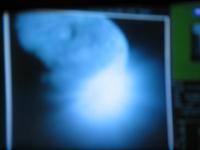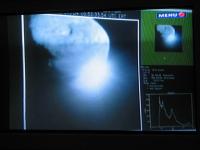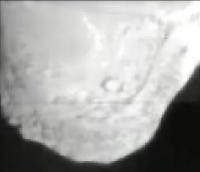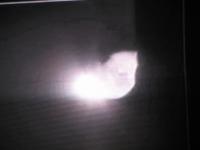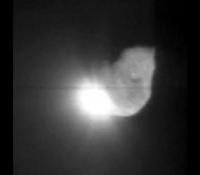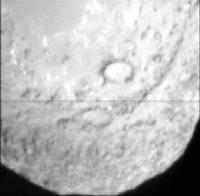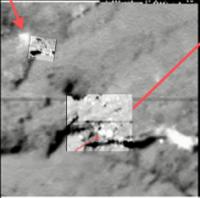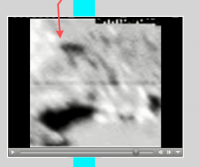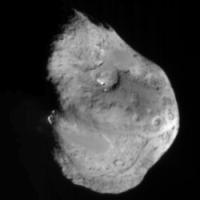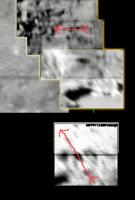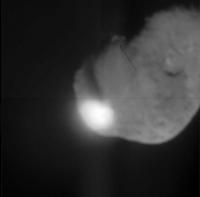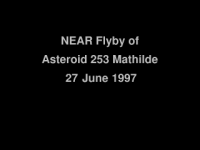Printable Version of Topic
Click here to view this topic in its original format
Unmanned Spaceflight.com _ Cometary and Asteroid Missions _ Deep Impact Realtime Thread
Posted by: djellison Jul 4 2005, 04:52 AM
Well - impactor TCM 1 went well - <0.3% error and it's on course for a nominal impact time. PI has suggested that the comet is Banana shaped and we're going to hit the end of it which looks a little triangular ![]()
Posted by: djellison Jul 4 2005, 05:09 AM
A rather rough and ready HRI picture on NASA TV - looks a bit like a distant startdust image.
Doug
Posted by: djellison Jul 4 2005, 05:19 AM
TCM 2 is in progress - estimated to be 40ish seconds long, be around 2.2m/sec and use around 0.3kg of fuel.
Doug
Posted by: hendric Jul 4 2005, 05:20 AM
Sounds like someone was concerned about microradians being too high, I assume it's a turn rate...
Posted by: hendric Jul 4 2005, 05:21 AM
Somebody just got up and ran off..."I told you to go to the bathroom before we started!"
Posted by: djellison Jul 4 2005, 05:22 AM
I assume this is the calculated pointing error for the MRI on the Impactor.
Pictures on NASA TV look amazing from the HRI! Couldnt help myself laughing, there's a great big impact crater like feature just about where the impactor will be targeting ![]()
Doug
Posted by: hendric Jul 4 2005, 05:23 AM
Figures...Nasa TV is showing images of the HRI. I see a crater!!!
Their lame Deep Impact IMage Viewer doesn't show CRAP.
More like an eggplant than a pickle..
Posted by: deglr6328 Jul 4 2005, 05:24 AM
Did I get that right? They're doing (near) real-time deconvolve?
..... >6Kg fuel remains, plenty for final targeting.
Posted by: hendric Jul 4 2005, 05:28 AM
Yep. On their laptops, no less. I guess Mike's comment that it would take 2 days is a bit of a schedule stretch. Then again their quick & dirty deconvolve might not be as good as a take your time Dc.
Posted by: djellison Jul 4 2005, 05:31 AM
Yup "Two days"...lmfao - 60 seconds ![]()
Doug
Posted by: hendric Jul 4 2005, 05:36 AM
holy...I thought the tv camera defocused, but those were actual HRI raw images deconvolved real-time!?! Those raw images looked like crap...
Posted by: djellison Jul 4 2005, 05:36 AM
For those with access - Sky News is carrying NTV as one of their multi-screen feeds
Doug
Posted by: djellison Jul 4 2005, 05:38 AM
Last TCM calculations suggest again, 2ish m/sec
Doug
Posted by: deglr6328 Jul 4 2005, 05:39 AM
Final ITM (ITM 3) occurs in <3 min. As I understand it, on board autonav targeting data indicates agreement with ground track (radio) data is within <1Km....
I have to say this is considerably more exciting than I had expected. ![]()
Posted by: hendric Jul 4 2005, 05:44 AM
"Near real time" my butt. The Image Viewer is a waste of bandwidth.
Posted by: djellison Jul 4 2005, 05:45 AM
FInal burn manouver complete - accurate to within 0.23% ![]()
Doug
Posted by: deglr6328 Jul 4 2005, 05:45 AM
Final TCM burn error less than 1/4 of a %!! ![]() wow
wow
time to impact is <5min.......
Posted by: djellison Jul 4 2005, 05:51 AM
10 seconds to go
Posted by: djellison Jul 4 2005, 05:52 AM
Loss of Signal ![]()
Posted by: djellison Jul 4 2005, 05:52 AM
WOoooooooooooooooooooooooooo - the pictures ![]()
Doug
Posted by: djellison Jul 4 2005, 05:53 AM
Wow - this is like ranger - amazing images coming in one after the other
Doug
Posted by: deglr6328 Jul 4 2005, 05:53 AM
WOW! lovely!! they look far closer than what was returned from stardust!! ![]()
![]() looks like the same weird flat bottom cratering!
looks like the same weird flat bottom cratering!
Posted by: hendric Jul 4 2005, 05:55 AM
Is that a crack?? My bet is for rubble pile!!
Posted by: djellison Jul 4 2005, 05:57 AM
Is it wrong that I was celebrating WAYYY before the scientists ![]()
Oh WOW - image showing the impact ![]()
Doug
Posted by: deglr6328 Jul 4 2005, 05:59 AM
It's perfect! Perfectly centered in the image frame is a conical ejecta image!! beautiful!!! ![]()
Posted by: alan Jul 4 2005, 06:03 AM
"doing very well for a spaceraft about to be vaporized" ![]()
Posted by: lyford Jul 4 2005, 06:03 AM
Doh - party's over here now.... ![]()
Posted by: djellison Jul 4 2005, 06:04 AM
Just taking photographs of my TV here - with Sky News carrying NASA TV
Doug
Posted by: lyford Jul 4 2005, 06:05 AM
more here
http://www.scotsons-shack.com/dimages.htm
Posted by: Bob Shaw Jul 4 2005, 06:07 AM
Good images of the nucleus - looks like a bent Enceladus!
Posted by: lyford Jul 4 2005, 06:07 AM
kitt peak working now
http://www.noao.edu/news/deep-impact/
Posted by: hendric Jul 4 2005, 06:10 AM
Deep Impact II to hit an Asteroid? ![]()
![]()
Posted by: deglr6328 Jul 4 2005, 06:13 AM
Sub-meter res images just before impact seem to show bright (ice?) patches on surface.....
Posted by: hendric Jul 4 2005, 06:14 AM
Consdering they're compensating for a really low albedo, "bright" is a pretty relative term.
Posted by: djellison Jul 4 2005, 06:20 AM
MRI of the impact.
I just have to go 'BOOOOooooooom' every time I see a new picture
Doug
Posted by: Sunspot Jul 4 2005, 06:21 AM
Any reports of observations from the ground?
Posted by: Bob Shaw Jul 4 2005, 06:27 AM
Doug:
Gonna send the Deep Impact Team a 'Golden Nail Gun' now?
Bob Shaw
Posted by: lyford Jul 4 2005, 06:27 AM
mirror of the pre impact animation from kitt peak
http://homepage.mac.com/lyford/deep/tempel1b.gif
Posted by: Bob Shaw Jul 4 2005, 06:32 AM
The final flyby picture before the 'hiding from the lumps' phase is amazing - a waning nucleus with ejecta plumes... ...roll on deconvolution!
Posted by: garybeau Jul 4 2005, 06:37 AM
The best 4th of July fireworks I ever witnessed. Congratulations to the Deep Impact Team
Posted by: djellison Jul 4 2005, 06:59 AM
The realtime image pages are healthily updated, but dog-slow and unreliable
Doug
Posted by: volcanopele Jul 4 2005, 07:01 AM
Try:
http://pirlwww.lpl.arizona.edu/~perry/images/impact15.jpg
replace 15 with any number from 2 through 28.
screengrabs from NASA TV
some initial interpretations: the circular features appear to be positive relief features, maybe low mesas. Combined with the scarps nearby, perhaps (and I know this was suggested for Wild 2) that cometary material is ejected from the scarps, eroding them back.
Compared to the simulation animation shown often in the last few days, the impact ejecta is mostly traveling laterally away from the impact site. the animation showed ejecta going straight back. Alex Dessler, who watched the event with me, thought he noticed the formation of several rays during the impact
Posted by: alan Jul 4 2005, 07:37 AM
impact images now available on near real time image viewer
Posted by: Sunspot Jul 4 2005, 07:55 AM
http://www.spaceflightnow.com/deepimpact/050704faulkes.html
The Faulkes Telescope in Hawaii captured these before (left) and after images that show the comet increases in brightness following the impact. Credit: Faulkes Telescope Project.
Posted by: Jyril Jul 4 2005, 07:56 AM
Faulkes Telescope images can be found http://www.faulkes-telescope.com/scied/deepimpact/deepimpact_new.html.
Posted by: deglr6328 Jul 4 2005, 08:04 AM
Pre and post (~20 minutes) images from the Faulkes telescope in HI. The brightening continues in the latest http://www.faulkes-telescope.com/scied/deepimpact/deepimpact_new.html.....
Ah! you beat me to it!! ![]()
Posted by: jaredGalen Jul 4 2005, 08:09 AM
What time GMT is the press conference on?
I don't trust my time conversion after I got up an hour earlier that I needed this morning.
It's gonna be a looooong day. Totally worth it though. ![]()
Edit: Ahh, never mind, it's "momentarily" apparently.... ![]()
Posted by: dvandorn Jul 4 2005, 08:11 AM
Now it's off of "Momentarily" and back to telling us it's supposed to start ten minutes ago... *sigh*...
-the other Doug
Posted by: Sunspot Jul 4 2005, 08:11 AM
I think it should have started 10 minutes ago. ![]()
Started......
Hubble images: http://hubblesite.org/newscenter/newsdesk/archive/releases/2005/17/
Posted by: Jyril Jul 4 2005, 08:11 AM
It should start at any time now. They're having some technical problems (!).
Posted by: jaredGalen Jul 4 2005, 08:12 AM
Arggghhhhh!! Maybe not.
Posted by: jaredGalen Jul 4 2005, 08:13 AM
WOOOHOOO!!!
Posted by: jaredGalen Jul 4 2005, 08:15 AM
Wow, more hits than Cassini and MER combined!
That's huge.... ![]()
Posted by: Jyril Jul 4 2005, 08:26 AM
http://planetary.org/blog/20050703.htm from Planetary Society for those who can't watch the conference.
Posted by: Tman Jul 4 2005, 08:50 AM
Someone did a nice animation on web:
http://planetary.org/deepimpact/images/encounter/animation-small.gif
Posted by: abalone Jul 4 2005, 09:08 AM
Still image from impactor. Impact point is in center of photo
Posted by: Decepticon Jul 4 2005, 12:03 PM
Did anyone get the reaction of the Deep Impact Team on file?
I missed it. I work nights.
I really would love to see this.
Posted by: Marcel Jul 4 2005, 12:52 PM
Before and after by Hubble
http://deepimpact.jpl.nasa.gov/gallery/jpg/Hubble_Witnesses_Crash.jpg
Posted by: ilbasso Jul 4 2005, 01:55 PM
I heard the rep from ESA say that Rosetta was also watching the impact so they could fine-tune their comet encounter 10 years from now.
The untold story: Rosetta actually impacted Tempel 1 last night, too...but it is going to take ESA 10 years to release the images!
![]()
Posted by: Tman Jul 4 2005, 03:30 PM
There is an QT movie that shows most approach so far: http://www.nasa.gov/mission_pages/deepimpact/multimedia/pia02125.html
But it's diificult to compare the surface of comet when final approach comes close. I treid to make a frame set that shows marks from frame to frame. In fact there are two main sequences that fit and two frames which do not. The order is the same as in the movie.
http://www.greuti.ch/deepimpact/Tempel1_approach_impactor.jpg
Posted by: djellison Jul 4 2005, 03:35 PM
It may be that it started to tumble / wobble with impacting in the last few seconsd perhaps?
Doug
Posted by: Jyril Jul 4 2005, 03:45 PM
The hubble image posted earlier has been updated with an image taken in 7:20 UT, where the debris cloud has expanded much larger:
http://hubblesite.org/newscenter/newsdesk/archive/releases/2005/17/
Posted by: Jyril Jul 4 2005, 03:47 PM
It may be possible. I got the impression that it was bombarded pretty heavily before the impact.
Posted by: volcanopele Jul 4 2005, 03:52 PM
But it's diificult to compare the surface of comet when final approach comes close. I treid to make a frame set that shows marks from frame to frame. In fact there are two main sequences that fit and two frames which do not. The order is the same as in the movie.
http://www.greuti.ch/deepimpact/Tempel1_approach_impactor.jpg
WOW, thanks for that sheet correlating features. I'm still trying to rap my head around this topography. They are definitely not craters. Given the scarps nature (with circular extentions), the seem most consistent with sapping, which makes perfect sense for a comet if these are the sites were jets form.
Posted by: volcanopele Jul 4 2005, 04:04 PM
http://pirlwww.lpl.arizona.edu/~perry/images/impact_site.jpg
I want to thank tman for his work on trying to track the motion of the impactor. I have taken two of his frames, one from early on and the second to last frame, to show the motion. I have identified the location of the second to last frame in the fourth from the beginning. This shows that the nucleus rotated under the impactor so that the sub-spacecraft point moved from lower right to upper left, from those two bright deposits to the low scarp at upper left. Some of the motion I see is definitely from lower right to upper left, on average, but there are a few deviations. Still, very odd frost deposits, definitely suggesting that we will find fresher ice beneath this dark surface layer (a la Phoebe).
Posted by: Tman Jul 4 2005, 04:25 PM
![]() wow, you found likely the right impact spot! I agree with it! Never thought that it's so far on the left.
wow, you found likely the right impact spot! I agree with it! Never thought that it's so far on the left.
Additionally we have to consider the shape of the comet that was "hanging over" for the impactor.
Posted by: jaredGalen Jul 4 2005, 05:59 PM
Looks Like your spot on.
I overlayed the closeup with the image taken further up.
They line up exactly.
Posted by: jaredGalen Jul 4 2005, 06:11 PM
In fact the last one seems to fit in too here.
This is very rough. But you get the idea.
Any takers....?
Edit: Although looking again....not too sure
Posted by: Decepticon Jul 4 2005, 06:24 PM
Cool animations!
This is a great press conference!
Posted by: djellison Jul 4 2005, 06:25 PM
1600GMT Press Conf Highlights ![]()
Web Hits : Last 24 hrs 1 billion hits. 2.5X that of busiest day for MER
Flyby Spacecraft in Great Shape - amazing picture post-shield mode, plume looks as large as the whole comet
Pre-Release targetting was a few km off to the left. Post ITM1 was way below the comet, Post ITM2 was just left of centre, and ITM3 just below and to the right of it.
New result : Map of temp of the Neuc pre-impact. Sub-solar part is warmest (obviously)
Ejecta/Outgassing coming out for several hours after impact.
Lots of topographic relief - things that really do look like impact craters.
Bright spots, mostly just steep sun-facing slopes - a couple are not. Almost certainly there is layering, jets coming from somewhere they hope to trace
Two circular features were refered to as craters
Sequence of videos - shadow caused by ejecta
Processed HRI imagery movie of impact - not THAT much better than the MRI movie
Height of ejecta on lookback image (at about 27,000km) 1000's of Km's height to ejecta. Mainly dust
Not 100% sure if they can actually see the crater - they have a 'feature' that may be the crater.
Approx 160kg useable fuel onboard flyby. Do not have specific extended mission plan currently, will probably mothball the spacecraft in a few weeks. (I assume to pick it up again in the future)
Further simualted impacts at the ames canon.
'Dual-ish' plume, i.e. one narrow straight-out plume, then a wider plume to follow. Happens when the impactor goes into the surface ( a soft layer ) then goes kerpow.
Doug
Posted by: Decepticon Jul 4 2005, 06:31 PM
Are raw images available yet?
Posted by: alan Jul 4 2005, 06:36 PM
Found a couple more matches in Tman's image
http://img151.imageshack.us/my.php?image=tempel1approachimpactor6es.jpg
Posted by: jaredGalen Jul 4 2005, 06:48 PM
Looks like you found a much better match alan.
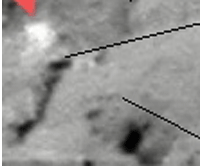
Posted by: Sunspot Jul 4 2005, 06:48 PM
It doesn't look like there are any plans for an extended mission.
........also I wonder if the focus problem with the HI camera has had a more serious efect on the science than anticipated.
Posted by: MizarKey Jul 4 2005, 06:49 PM
I loved the animated sequence showing the crater formation and the 'jet' it caused. I can't wait to see some of the other processing in the next few days.
I wonder if the new jet has changed the trajectory at all (you would think it would have to have). I've seen several places where people have expressed concern that they will have knocked the comet into an Earth collision course. I find it interesting that people think Nasa would even consider attempting doing something like that. I mean, the first thing they probably looked at was "will this endanger the Earth in any way?" There will always be the Chicken Littles I guess.
Well, the 'electrical comet' people will have reassess their theories, I didn't see any lightening bolts leaping off the surface toward the copper impactor.
I'm sure there will be some adjustments necessary to mainstream comet structure ideas too though...don't think they expected the craters.
Eric P / MizarKey
Posted by: volcanopele Jul 4 2005, 07:01 PM
I'm still finding it hard to believe think of those circular features as craters, the shadows are all wrong, but I'll reserve judgement. The circular feature at left in this image:
http://pirlwww.lpl.arizona.edu/~perry/images/impact48.jpg
maybe a crater though
Posted by: Phil Stooke Jul 4 2005, 09:10 PM
Here I've tinkered with the brightness to see the terminator area better.
A lovely new world! Despite what A'Hearn said I think this is quite a lot like Borrelly in many respects - but we see it a lot better. It's VERY different from the weird Comet Wild-2, with its amazing spiky hills and scarps. The top is rotating towards us, meaning cometary north is to the right (the new IAU definition of north on objects like these).
Note how the two smooth patches give the appearance of lying in the the central portions of broad shallow depressions. A proper shape model will be made later, so I hope it confirms this. Despite VP's comments, I don't have a problem interpreting the circular features as impact craters, though presumably if the artificial impact tells us anything it should be that natural impacts will trigger venting and the crater will evolve rapidly. But the dark shading VP mentions looks to me like the outer part of the rim on one side, and the inner part of the rim on the opposite side... it looks OK as a crater to me. Well, we'll see... I have my opinions, but I've been wrong before. (just ask my kids!)
Phil
Posted by: MiniTES Jul 4 2005, 10:06 PM
Let me get this straight: they're not sure if they see the crater? The whole point of the mission was to look inside the crater to see the interior of the nucleus! Don't get me wrong, the nucleus photos are great and the impact photos are absolutely spectacular, but what about the science?
Posted by: john_s Jul 4 2005, 10:13 PM
I don't think it's that bad- the main way they planned to see what was in the crater was to watch that stuff being blasted out into space, rather than look at what was left behind in the hole- they will have lots of data on what's inside the comet. But seeing the crater would tell a great deal about the strength of the nucleus and about impacts in general. If they can't see the crater through the the plume, it will be a disappointment, but not a disaster.
Posted by: MiniTES Jul 4 2005, 10:20 PM
I see. I thought they wanted to see the layers of the interior of the comet in cross-section. Although it seems like the majority of the imaged are still being downlinked.
Posted by: MiniTES Jul 4 2005, 11:35 PM
Trying to make sure I understand the geometry of the image: in the lookback image, the really bright spot is the sun, right? (As opposed to the plume from the impact)
Posted by: Decepticon Jul 5 2005, 12:10 AM
I though we would get better lookback images for mapping.
Posted by: Phil Stooke Jul 5 2005, 12:40 AM
MiniTES, the brightest spot in the lookback image is the plume. The illuminated part of the nucleus shows the general direction to the sun, but it's far off to the side. The plume looks extra-bright in forward-scattered light.
Phil
Posted by: BruceMoomaw Jul 5 2005, 01:48 AM
Actually, the scientific seriousness of the HRI focusing problem has been greatly diminished by the other problem: the fact that the ejecta cloud utterly hid the impactor crater. When you read A'Hearn's and Belton's original article setting forth the science rationale for this mission ( http://deepimpact.jpl.nasa.gov/science/cospar-ms.pdf ) , they DO emphasize looking for layering in the crater walls as one of its most important justifications -- and it's precisely for that reason that they wanted such a very high-powered HRI with a top resolution of "1 meter/pixel", since the layering structure may well be that fine.
Well, of course, the obscuring ejecta cloud has totally ruined that scientific goal for the mission, and would have in any case. And since the Impactor Camera imaged the approach side of Tempel every bit as well as a perfectly focused HRI would have (its resolution and viewfield at 140 km distance was the same as the HRI's at its own minimum distance of 700 km, and at that point the Impactor Camera was still totally non-sandblasted), virtually the only thing we ended up actually losing from the HRI problem was somewhat sharper photos of the OTHER side of the nucleus. Moreover, when you compare the deconvoluted HRI photos of the impact itself with those from the MRI ( http://www.nasa.gov/mission_pages/deepimpact/multimedia/pia02123.html and http://www.nasa.gov/mission_pages/deepimpact/multimedia/PIA02131.html ), it's clear that deconvolution -- even if it didn't completely solve the HRI problem -- has still allowed the creation of photos maybe 3 times sharper than those from the MRI (as opposed to the originally hoped-for 5 times).
But that ejecta cloud -- whose power to blot out the impact crater was always a very strong possibility, even if it hadn't been remotely as big as it actually turned out to be -- raises the question: just how good, really, was the science rationale for this mission? (Hawaii's Jeffrey Bell, playing his usual role as the Skeleton at the Feast, has been raising this point in E-mails to me for years.) It's now clear that, if we really wanted to study the comet's surface layering, it might have been a far more dependable technique to simply put a radar sounder on the craft -- which would also have covered a vastly wider area on the surface, perhaps incuding sites of activity, and could have been used on more than one comet. (The sounder's antenna could have been put in the "shadow zone" protected by the craft's forward dust shield.) Moreover, by eliminating the great mass and cost of the Impactor, we could also easily have added gas and dust-impact mass spectrometers a la CONTOUR and Stardust. In short, this mission -- for less cost -- could have instead been a vastly improved version of the multi-comet CONTOUR mission. Just about the only thing we actually got out of Deep Impact that such an alternative mission couldn't have provided was the data the impact may have provided on the chemical composition of really deeply buried subsurface ices -- and was this enough to compensate for the other stuff we passed up?
This returns me to something I've wondered about for years: just how did Deep Impact actually get selected? Its selection was a total surprise to me; it muscled ahead of other Discovery finalists -- Aladdin, and a VESAT or VESPER Venus orbiter -- which were not only finalists this time but had been during the previous selection, too (which D.I. never had been). Is it possible that Dan Goldin intervened and ordered the selection of Deep Impact as yet another of his harebrained NASA PR stunts with questionable science return (Mars Pathfinder, with its cute but scientifically mediocre rover and not-very-efficient airbag system; the cancelled 2003 miniature Mars Airplane; the proposed all-girl Shuttle flight; the cancellation of a sensible 2003 Pluto probe in favor of a far more difficult and technically sophisticated early Europa Orbiter, with the highly predictable result thaat we got neither)? I already know that NASA HQ virtually ordered the selection of Phoenix in the supposedly "independent" 2007 Mars Scout selection; we were explicitly told so at the first Mars Roadmap meeting.
Posted by: tedstryk Jul 5 2005, 02:23 AM
Were the images taken after impact monochrome or multispectral? If multispectral, there a chance that anything "behind" the cloud might be pulled out. Actually, depending on opacity, this might happen with monochrome images too.
Posted by: MiniTES Jul 5 2005, 02:38 AM
This returns me to something I've wondered about for years: just how did Deep Impact actually get selected? Its selection was a total surprise to me; it muscled ahead of other Discovery finalists -- Aladdin, and a VESAT or VESPER Venus orbiter -- which were not only finalists this time but had been during the previous selection, too (which D.I. never had been). Is it possible that Dan Goldin intervened and ordered the selection of Deep Impact as yet another of his harebrained NASA PR stunts with questionable science return (Mars Pathfinder, with its cute but scientifically mediocre rover and not-very-efficient airbag system; the cancelled 2003 miniature Mars Airplane; the proposed all-girl Shuttle flight; the cancellation of a sensible 2003 Pluto probe in favor of a far more difficult and technically sophisticated early Europa Orbiter, with the highly predictable result thaat we got neither)? I already know that NASA HQ virtually ordered the selection of Phoenix in the supposedly "independent" 2007 Mars Scout selection; we were explicitly told so at the first Mars Roadmap meeting.
Bruce: You bring up some interesting points. However, one thing to note about Deep Impact is that the media coverage of it, at least in online sources, is about as good as anything I've seen on an unmanned mission, and probably better, and I fully expect to see photos of impact on the front page of every major newspaper tomorrow morning. The explosion and the July 4th impact seems to really provide instant gratification for those who don't like waiting for all that boring science to come out of these missions. After all, why wait a week or two to wait for the data to be downlinked and some extremely basic conclusions made about the comet when you can ask questions about tunnels on the nucleus today?
That said, I think there is some valuable science here. We will have some good information on the interior makeup of the comet if the spectroscopy goes well, and we already have some good images. And you must admit that whatever their scientific value may be, those impact images are jaw-dropping. Usually you only see stuff like that in artists' conceptions! Bruce, do you know if the July 4th date was chosen intentionally or "ordered" by our good friend Mr. Goldin?
Posted by: BruceMoomaw Jul 5 2005, 02:40 AM
To Ted: both the HRI and MRI images were multispectral -- but as yet, I don't have the wavelengths or even the number of filters. I'll continue digging. (There is a good simulation of what they were hoping for from the HRI, when it came to observing layers in the imact crater walls, at http://deepimpact.jpl.nasa.gov/tech/hri.html .)
Posted by: MiniTES Jul 5 2005, 02:46 AM
I think there are six colors in the MRI filter wheel, if I recollect an article in the Planetary Report correctly.
Edit: This source gives nine colors for MRI: http://www.deepimpact.umd.edu/collaborative_ed_module/7Appendix/MarriottIntervSheet.pdf
Edit 2: This source gives nine for both. Nothing on the wavelenghts they let in, though. http://www.beltonspace.com/bsei_web_page_g000000.pdf
Posted by: MiniTES Jul 5 2005, 03:07 AM
I also think NASA could have milked the publicity far more effectively than they actually did with just the one press conference. Although kudos must go out to the Deep Impact team for providing us space aficionados with images and animations within just minutes of impact.
Posted by: BruceMoomaw Jul 5 2005, 04:19 AM
To "Mini-TES": actually, your second source -- an EXTREMELY useful-looking paper I'd never seen before (thanks) -- DOES list the colors of the two cameras' filters. It describes both cameras as having 9 filters, but only 7 color filters: the others probably include one clear filter, and one specialized one (such as polarized).
"Filters for the MRI (Hampton et al., this issue) are chosen to detect coma
components; five of the seven filters in the MRI camera set are narrow bands optimized for coma observations, leaving two wider bands centered at 750 and 850 nm matching those on the HRI. The HRI filters are set at 100 nm intervals between 350 and 950 nm, to determine visible color characteristics without detailed spectroscopy, which investigation is done by the infrared instrument. At visible (.4 to 1 µm) wavelengths, cometary nuclei exhibit a wide range of linear slopes (Jewitt 2002). Reasons for this diversity remain unclear."
Posted by: BruceMoomaw Jul 5 2005, 04:21 AM
As for an extended mission to a second comet; I carefully examined that statement at the press onference, and it definitely isn't a disavowal of it -- it's just a statement that whether or not they do it depends on whether they can scrounge the money from NASA. (I think they'd be fools not to, especially given the failure of CONTOUR and the fact that the DI spacecraft can spend most of its cruise time to the second comet in hibernation mode to save money.)
Posted by: BruceMoomaw Jul 5 2005, 04:29 AM
And as for the impact being precisely on July 4 (well, actually, July 3 U.S. time): A'Hearn once dropped the comment that this was "not accidental". Beyond that, I know nothing.
Posted by: BruceMoomaw Jul 5 2005, 05:14 AM
And here, finally, is the only additional data I was able to scrounge on Google about the cameras' filter wheels -- A'Hearn's brief descriptions of them:
pds-smallbodies.astro.umd.edu/review/ comets200410/di/ditv_0004/catalog/inst_hrivis.cat
pds-smallbodies.astro.umd.edu/review/ comets200410/di/ditv_0004/catalog/inst_mrivis.cat
Both are described as having "two clear apertures" in addition to their color filters -- but the MRI is descri bed as having 8 color filters instead of 7. Since the description of the mission in Mini-TES' paper is more recent, it's probably correct in saying that the MRI was reduced to 7 filters. (There is a little more data on the exact nature of the filters in A'Hearn's descriptions, though.)
"Mini-TES'" paper is from the June issue of "Space Science Reviews", devoted entirely to this mission. Unfortunately, Hampton's article in that issue describing the MRI filters is not yet on the Web -- but another paper from that issue, on the nature of Tempel 1 itself, is also available already:
http://www.beltonspace.com/bsei_web_page_g000007.pdf
Posted by: BruceMoomaw Jul 5 2005, 05:23 AM
And here's a third one, which is useful in being the most detailed description yet of exactly what the hell they hoped to get out of this mission scientifically. I'll take a careful look at this before criticizing this mission again.
http://www.beltonspace.com/bsei_web_page_g000002.pdf
Posted by: slinted Jul 5 2005, 05:59 AM
Bruce:
The pds site with the calibration data has a file describing the filters with a bit more detail :
http://pdssbn.astro.umd.edu/review/comets200410/di/ditv_0004/index/index.lbl
DESCRIPTION = "Provides the number of the commanded filter;
For HRIVIS:
Fil Filter Center
# Name (nm)
--- ------- ------
-9 N/A N/A; used for HRIIR
0,1 CLEAR1 650
2 BLUE 450
3 GREEN 550
4 VIOLET 350
5 IR 950
6 CLEAR6 650
7 RED 750
8 NIR 850
9 ORANGE 650
For MRIVIS:
Fil Filter Center
# Name (nm)
--- ------- ------
-9 N/A N/A; used for HRIIR
0,1 CLEAR1 650
2 C2 514
3 GREEN_CONT 526
4 RED 750
5 IR 950
6 CLEAR6 650
7 CN 387
8 VIOLET_CONT 345
9 OH 309
Posted by: BruceMoomaw Jul 5 2005, 03:59 PM
Splendid! Thanks.
Posted by: Tman Jul 5 2005, 05:02 PM
Maybe you want to get a deeper look at the impact area ![]()
http://www.greuti.ch/deepimpact/Tempel1_final_approach2.jpg
I'm not really sure about the location of the last picture. The small mound beside the dark "cave" don't fit exactly enough (to me).
Posted by: alan Jul 5 2005, 05:17 PM
What small mound?
Posted by: Tman Jul 5 2005, 05:39 PM
This one:
http://www.greuti.ch/deepimpact/Tempel1_final_approach3.jpg
I dont know. Other marks fit good therein. Probably it's the quality of the pictures that makes the differences.
Posted by: djf Jul 5 2005, 07:45 PM
Very nice collage image, Tman, thanks for posting.
I cannibalized it to show my impression about the orientation and location of the final frame you show at the bottom. I think one issue is that the impactor was rotating and wobbling near the end...
The attached image is pretty crude compared to most of what's posted here, but it was easier to show with an arrow on the images than describe in text.
Thoughts?
Posted by: Tman Jul 5 2005, 09:02 PM
Since I saw this newer or other movie of the approach: http://www.nasa.gov/mission_pages/deepimpact/multimedia/070405-its-approach-x4.html
I would also say the impactor (camera) got a change, maybe because of an hit. I guess the primary direction of the impactor approach has been kept, but the camera turned toward the surface and showed then a "fly by" of the (more and more) nearer surface.
Posted by: 4th rock from the sun Jul 5 2005, 11:34 PM
Hum, I think that's an out of focus image
Bright edges can look double if your telescope is out of focus.
Posted by: Bob Shaw Jul 5 2005, 11:51 PM
Bright edges can look double if your telescope is out of focus.
Looks awfully like camera shake!
Posted by: Bob Shaw Jul 5 2005, 11:59 PM
Phil:
My first impression of Tempel-1 was a mini-Enceladus; I'd now modify that to a cross between Enceladus and Eros/Phobos. I'm thinking gas-driven surface flows, and funny materials here, plus global-scale chains of 'things' (craters, inside-out-mesas, whatever - perhaps a bit like the Martian south polar CO2 landscapes...).
Roll on Dawn!
Bob Shaw
Posted by: BruceMoomaw Jul 6 2005, 07:35 AM
Regarding the final images from the Impactor, three notes:
(1) It turns out that the blurry quality of the final images was due mostly to the simple fact that they returned less and less of each of frame toward the end in order to allow them to be returned fast enough only the central 64 x 64 pixel portion of each of the last few frames was returned! No wonder they looked blurry.
(2) It seems to me that in the final frames, we are definitely looking at horizontal image smearing -- but this is hardly surprising, and it doesn't require that the Impactor lost its pointing stability. Its AutoNav system was programmed to point the camera at the center of brightness of the nucleus -- but after the nucleus filled the screen, of course this meant no further change in attitude at all even though the Impactor was bound to be approaching the nucleus at a real angle slightly different from the direction calculated by AutoNav the last time it calculated the right pointing direction for the camera. So -- at close range -- they naturally got some smearing, which is greatly amplified in its appearance by the fact that only a small part of each final frame was returned (plus the fact that it was approaching the nucleus four times faster than the Rangers crashed into the Moon).
(3) Note one more interesting terrain feature in the last frames: lots of tiny little sharp-peaked pinnacles, similar to the larger ones seen in Stardust's longer-range Wild 2 photos. These are presumably caused by the same sublimation processes that create the "mesas" and the steep walls on the circular depressions -- namely, the fact that lag deposits of dust left behind as the comet's ice sublimates build up into a shield to inhibit the further erosion of horizontal surfaces, but slide off steeply slanting ones to expose fresh ice, and thus cause initial mesas to steadily shrink in horizontal width while retaining their steep slide slopes.
Posted by: BruceMoomaw Jul 6 2005, 07:40 AM
I see I needed to proofread my first paragraph. Let's try again:
"(1) It turns out that the blurry quality of the final images was due mostly to the simple fact that they returned less and less of each frame toward the end, in order to allow them to be returned fast enough -- only the central 64 x 64 pixel portion of each of the last few frames was returned! No wonder they looked blurry."
Actually, when you take into account the natural graininess and horizontal smear in the last images, I don't see any clear sign at all of additional deterioration due to sandblasting of the camera mirror.
Posted by: edstrick Jul 6 2005, 09:04 AM
I haven't a gif-animator software that can take apart the animated gif of the impactor zoom movie, but my impression of the last frames is that the spacecraft is being hit and jerked around by smaller and larger impacts. There are discontinuous jerks, then several frames in a sequence where the field of view pans across an area, then another jerk or pan in a different direction. Most images are sharp, but some of the ones where the view jerks seem smeared, and the last images are smeared. Some of that will actualy be deconvolvable. Smear is one of the standard deconvolution jobs, as is defocus.
Nearly all the impactor images except the last subframes will be combinable in super-resolution images due to large oversampling, with the positions of individual pixels shifting as the nucleus zooms in view. Expect that the final data at any range will have very roughly twice the apparent resolution as the raw data.
Posted by: Decepticon Jul 6 2005, 11:55 AM
I got the sense the impactor was rolling as it hit.
Posted by: MizarKey Jul 8 2005, 05:18 AM
 mfb_frame_039.bmp ( 76.05K )
: 420
mfb_frame_039.bmp ( 76.05K )
: 420
Edstrick, I highly recommend http://www.irfanview.com/. It's an easy to use graphics program...I mainly use it for easy viewing of photo directories, but it does generate frames from animated gifs. It's free and supports a lot of file types.
You know, Temple1 reminded me a little bit of Mathilde when NEAR flew by it. I've attached a frame showing a crater near the terminator (the terminator is comprised of a large crater) that has a roughly rectangular white spot near its edge. You can easily see the white spot in the animate gif, but for some reason (not advancing any theories here) all the 'public' images of Mathilde do not show it or its somewhat blurred out. It could be a big chunck of ice similar to Temple1's white spots.
Eric P / MizarKey
Posted by: edstrick Jul 8 2005, 08:18 AM
I use ACDSee Classic for image brousing and viewing, I've never found anything close. I also use it as a file manager, it's got features Winbloat never thought of. The Classic version is up to 2.43 or something. The main version is up to version 7, but it's got so many bells and whistles added, I find it nearly unusable. It's like a Swiss Army Knife, only worse. I also use it as my main file manager for 90% of my tasks. It's got features Winbloat never thought of.
I'll try irfanview for the gif handling, though.. and NEAT Mathilde gif.. I've never seen that.
Posted by: djellison Jul 8 2005, 09:02 AM
http://picasa.google.com/index.html
It's ace ![]()
Posted by: Phil Stooke Jul 8 2005, 12:29 PM
Reply to MizarKey:
I'm not sure which bright spot on Mathilde you are referring to, but it's not very useful to rely on the animated GIF for anything. All the Mathilde original images are available through the PDS Small Bodies Node, and even more useful for you might be the maps and mosaics of Mathilde at this URL:
http://www.ssc.uwo.ca/geography/spacemap/mathilde.htm
Phil
Powered by Invision Power Board (http://www.invisionboard.com)
© Invision Power Services (http://www.invisionpower.com)
